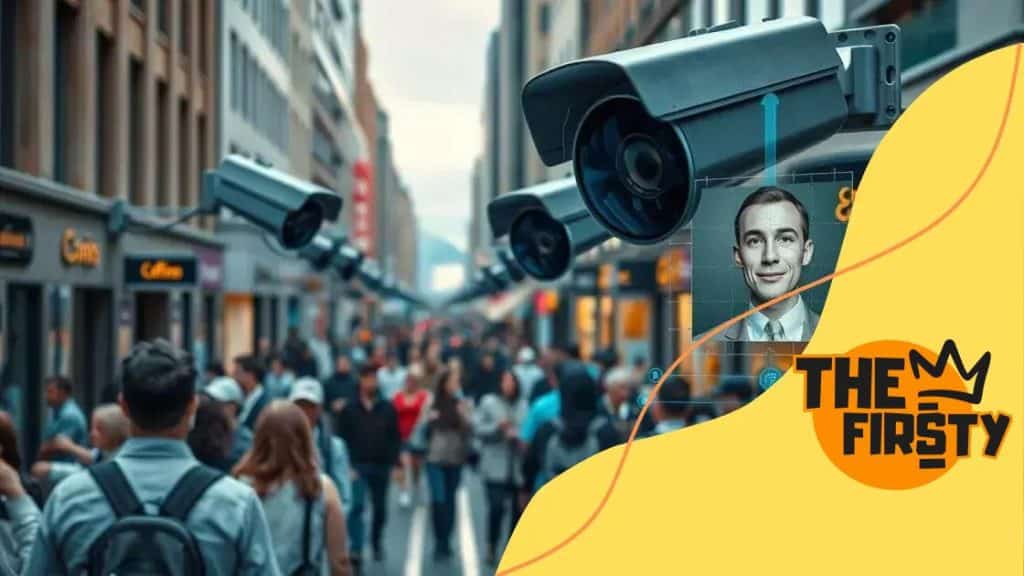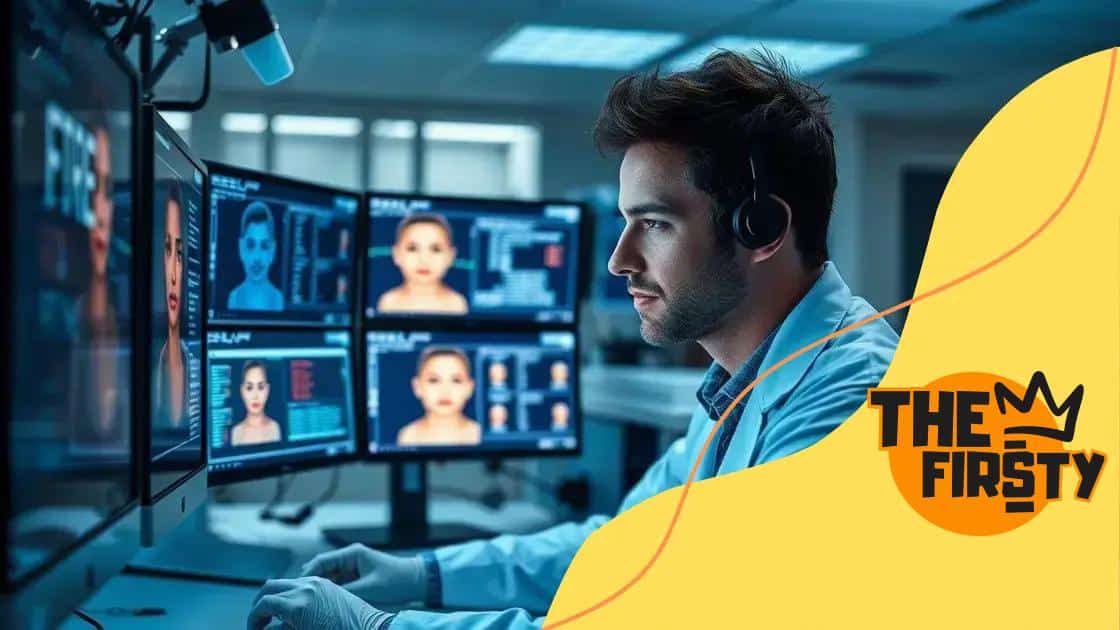The role of facial recognition in enhancing public safety

Anúncios
The role of facial recognition in enhancing public safety involves rapid identification of individuals, improved law enforcement responses, and potential ethical concerns regarding privacy and bias in data usage.
The role of facial recognition in enhancing public safety is a topic that’s gaining traction across the globe. Have you ever thought about how this technology impacts your safety in public spaces? Let’s dive into the intricacies of this intriguing subject.
Anúncios
Understanding facial recognition technology
Facial recognition technology is becoming increasingly important in our lives. It helps us identify people through their unique facial features. This technology has several applications, from securing our smartphones to enhancing public safety.
How Facial Recognition Works
This technology involves several steps. First, it detects human faces using algorithms. Then, it measures specific points on the face, such as the distance between the eyes and the shape of the jawline. By doing this, it creates a facial signature that can be matched against a database.
Applications in Daily Life
Facial recognition is not just used by law enforcement. Many companies use it to improve customer service. For example, retail stores may monitor customers to understand shopping habits better.
Anúncios
- Smartphone unlock features
- Airport security checks
- Social media tagging options
- Retail analytics
Moreover, this technology can enhance security in various public spaces. It can quickly alert authorities if a known criminal is nearby, acting faster than traditional methods. Imagine walking through a city where facial recognition helps police prevent crime before it happens.
Benefits and Concerns
While the benefits of facial recognition technology are significant, there are concerns too. Privacy issues arise as more cameras are installed in public. People worry about being constantly watched without consent. This raises important questions about control and surveillance.
Despite these concerns, many believe that facial recognition can make society safer. Balancing its use in public safety with the need for privacy will be crucial as we move forward.
Benefits of facial recognition for public safety
The benefits of facial recognition for public safety are significant and varied. This technology provides law enforcement agencies with powerful tools to enhance security in many environments. By quickly identifying individuals, it can prevent crime and promote a sense of safety in the community.
Rapid Identification
One of the main advantages of facial recognition is the rapid identification it offers. Police officers can access databases to find out if a person has a criminal record. This enables them to act swiftly in critical situations.
- Quick response to threats
- Efficient suspect tracking
- Enhancement of public space security
- Better crowd management during events
Beyond law enforcement, this technology can help organizations in various sectors. For instance, airports use facial recognition to improve passenger flow, making travel safer and faster.
Crime Deterrence
The presence of facial recognition systems can deter potential criminals. Knowing that their faces are being monitored may discourage them from engaging in illegal activities. This proactive approach can help create a safer environment for everyone.
Furthermore, facial recognition can assist in locating missing persons. By scanning crowds, authorities can quickly identify individuals who may be in danger or who have been reported missing.
In summary, the benefits of facial recognition for public safety extend beyond simple identification. They encompass a wide range of applications that enhance security, deter crime, and help maintain order in our communities.
Challenges of implementing facial recognition

Implementing facial recognition technology comes with several challenges that can impact its effectiveness and acceptance. These obstacles go beyond technical issues and often touch on ethical and privacy concerns.
Privacy Concerns
One of the biggest challenges with facial recognition is the potential invasion of privacy. Many people feel uncomfortable knowing that their faces can be scanned and stored without consent. This raises questions about how information is used and who has access to it.
- Potential for misuse of data
- Lack of consent from individuals scanned
- Concerns about surveillance overreach
- Fear of false identification
Public sentiment plays a crucial role in the acceptance of this technology. If the community does not trust how their data is managed, the implementation might face significant opposition. Transparency in operations is vital to build that trust.
Technical Limitations
Beyond privacy, there are technical challenges. Facial recognition systems can struggle in certain conditions. Poor lighting or obstructed views can lead to inaccuracies. This can have serious consequences, especially when accuracy is critical.
Furthermore, biases in algorithms can lead to unfair treatment of different demographic groups. If the technology is not trained on diverse datasets, it might misidentify individuals with unique features due to inadequate representation.
Addressing these technical flaws is essential for reliable use. Continuous testing and improvement of the algorithms can help mitigate biases and enhance overall performance.
In conclusion, overcoming these challenges will be key to the successful integration of facial recognition technology in society. Collaboration among developers, law enforcement, and the community is necessary to ensure that the benefits outweigh the downsides.
Ethical considerations in facial recognition
There are significant ethical considerations in facial recognition technology that need careful examination. As this technology becomes more prevalent in public and private sectors, its implications for individual rights and societal norms become increasingly important.
Data Privacy
An essential ethical issue revolves around data privacy. Facial recognition systems often collect and store large amounts of personal information without users’ knowledge. This can lead to unauthorized surveillance and data breaches, putting individuals’ privacy at risk.
- Unauthorized facial data collection
- Potential misuse by corporations or governments
- Risks of hacking and data leaks
- Lack of transparency in data management
People may feel uncomfortable knowing that their likeness can be captured and analyzed without their consent. Therefore, addressing privacy concerns is crucial for gaining public trust.
Bias and Discrimination
Another profound ethical concern is the potential for bias in facial recognition algorithms. If these systems are not trained on diverse data sets, they may perform poorly for certain demographic groups, leading to unfair or discriminatory practices in law enforcement and security.
This bias can result in wrongful accusations and misidentifications, particularly affecting minority groups. It raises serious questions about fairness and equality in the application of technology.
Implementing rigorous testing and accountability measures can help mitigate these ethical challenges. Developers must prioritize fairness and ensure their systems are equitable for all users.
Moreover, open dialogue about the ethical implications of facial recognition is essential. Engaging the community and stakeholders can lead to better policies and practices that respect individual rights while utilizing technological advancements.
Future prospects of facial recognition in law enforcement
The future prospects of facial recognition in law enforcement are vast and evolving. As technology advances, we can expect to see even more enhanced functionalities that will assist police work significantly.
Integration with Artificial Intelligence
One key area of growth is the integration of facial recognition with artificial intelligence (AI). This combination can enhance the accuracy of identifying suspects and help law enforcement predict criminal activity. AI can analyze patterns, providing valuable insights into crime trends that can guide police operations.
- Improved accuracy in face matching
- Real-time threat detection
- Data analysis for better decision-making
- Automation of routine tasks for efficiency
This advancement could lead to faster responses to emergencies, which is vital for public safety. Law enforcement agencies will be able to deploy resources more effectively, focusing on areas with higher reported incidents.
Community Engagement and Transparency
As facial recognition becomes more prevalent, engaging with the community is crucial. Building trust through transparency will determine public acceptance. Law enforcement must openly communicate how the technology works and how they protect citizens’ rights and privacy.
Community outreach programs will be essential for educating the public about the benefits and limitations of facial recognition technology. Encouraging feedback will also help agencies address concerns and adapt practices accordingly.
Moreover, legislation will likely evolve to regulate the use of facial recognition technology. Developing clear guidelines can ensure it is used ethically while maintaining public safety.
In summary, the future of facial recognition in law enforcement holds promise for enhanced security and improved community relations. By leveraging technology responsibly and engaging the public, agencies can create more secure environments for everyone.
In conclusion, the role of facial recognition technology in enhancing public safety is both significant and complex. As this technology continues to develop, it offers valuable tools for law enforcement while also raising important ethical and privacy concerns. Engaging with communities and ensuring transparency can help foster trust in its use. By addressing challenges with care, we can harness the benefits of facial recognition for a safer future while respecting individual rights and freedoms.
FAQ – Frequently Asked Questions about Facial Recognition Technology
What is facial recognition technology?
Facial recognition technology identifies or verifies a person by analyzing their facial features using algorithms.
How can facial recognition enhance public safety?
It can help law enforcement quickly identify suspects, monitor public spaces, and prevent crime, improving overall safety.
What are the privacy concerns associated with facial recognition?
Privacy concerns arise from the potential for unauthorized data collection and surveillance, leading to a lack of trust in its use.
Are there ethical issues related to facial recognition technology?
Yes, ethical issues include bias in algorithms and the need for transparency in how data is collected and used.





